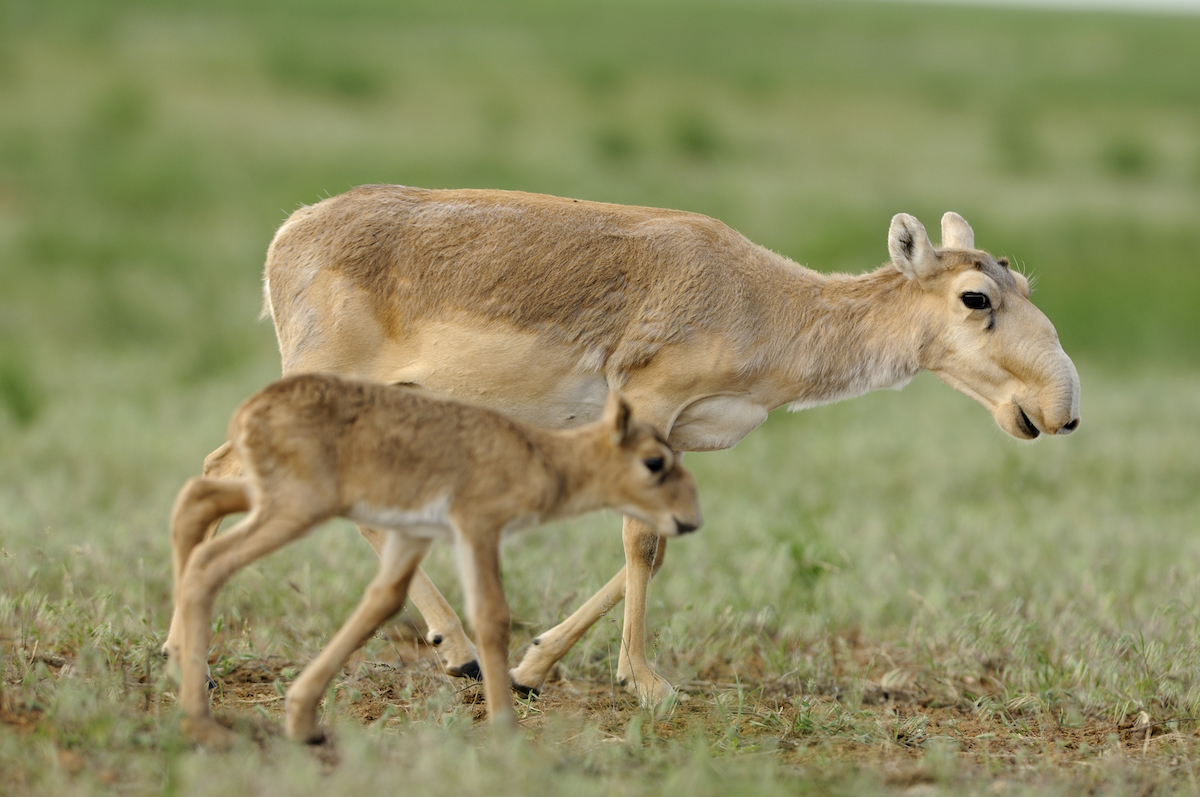 Evolution & Behaviour
Evolution & Behaviour
The saiga antelope is hit by a meteorological bullet
Saiga antelope of Central Asia suffered massive mortalities from a bacterial disease causing blood poisoning, threatening their survival. Evidence accumulated from research scientists is unravelling the mystery, which relates to weather/climate anomalies.

Saiga, a central Asian antelope, known for their bizarre facial features and as a unique survivor of the Pleistocene, is facing a crisis. In May of 2015, when their population was finally recovering from poaching during the collapse of the Soviet Union, reaching a quarter of a million animals, a mass mortality struck. The event was unprecedented in large mammals. 100% of 15 discrete herds of up to 60,000 animals suddenly died during the calving period, spread across a vast landscape larger than the British Isles and in each case within a week.
The event attracted huge public interest and an International team from Europe and Kazakhstan led by the Royal Veterinary College London, was able to unravel some of its mysteries.
A systematic forensic analysis of the freshly dead saiga was used to obtain a diagnosis of the immediate cause of death and in addition, a systems-based study of other factors that might have contributed to this event. This required a unique interdisciplinary team.
The animals suffered a rapidly evolving blood infection, with a common bacterial species, Pasteurella multocida , that is often part of the natural microbiome in the tonsils of mammals but can invade the body opportunistically. This led to a bleeding disease and death within hours affecting all adult animals. No other microorganisms were involved, confirmed by advanced molecular genetic techniques applied to samples. Calves of one or two days of age, which have not yet acquired their natural bacteria from the mothers, died more slowly, either from drinking contaminated milk or through starvation. This explained the distressing sight of hundreds of thousands of dead saiga across the steppe with offspring bleating and searching in a confused state.
They all died save for a few peripheral herds mostly in the North, which were found later, but why? This question was in part, answered by our study team. We investigated all possible risk factors and showed that during the 10 days prior to this event, unusual weather had occurred. No other contributory factor, be it related to soil, water, plant, chemical or toxin or the host itself could be found. This was possible given detailed study of pathology, the organism, the environment and from modelling the die-off against meteorological data from satellites acquired and stored over decades. Historical research showed that similar unstudied die-offs had occurred amongst saiga on a few occasions since the 1980s. By pooling data from these years and comparing them with data from years when nothing happened, we were able to do a discriminate analysis. It was robust and showed that the only risk factors of significance were higher than average temperatures and humidities, created by the weather systems moving across this landscape during May 2015, 1981 and 1988, when mass mortalities occurred.
Weather-triggered bacterial sepsis is the only plausible explanation for this landscape- and population-level effect. It was this process that apparently led bacteria to invade at a time when saiga are particularly vulnerable, when at a peak of metabolic demand, transitioning from winter to summer, losing their winter coat (perhaps not quickly enough) and were in some way challenged by the heat and humidity. The mechanism by which the microorganisms and/or the host resilience responded universally to these conditions, to allow invasion of the blood stream by normally passive bacteria remains enigmatic but theories exist and research continues.
Diseases associated to Pasteurella have been known in mammals and birds for over a century and it is mostly controlled in domestic animals through vaccination. It can be a vicious pathogen but never has an outbreak been so comprehensive in its impact and seemingly unbiological in its evolution. It appears this problem is unique and modern, there is no historic precedence before the 1980s and it is tempting to link this to human influence. The most likely candidate is climate change, which it might well be associated with but it is probably still too early to tell. Saiga evolved for a highly specific life cycle, in a challenging environment of extremely low and high temperatures seasonally, with fine margins of endurance, which may now be exceeded, pushing them beyond their adaptive capacity! Human influence on nature whether by the gun or on microorganisms, earth systems and environment can clearly be devastating in a wholly unexpected way and people need to wake up before it really is too late. Humans are mammals too.
Original Article:
R. Kock et al., Saigas on the brink: Multidisciplinary analysis of the factors influencing mass mortality events. Sci Adv 9, (2018)Edited by:
Massimo Caine , Founder and Director
We thought you might like
More from Evolution & Behaviour
Cicada emergence alters forest food webs
Jan 31, 2025 in Evolution & Behaviour | 3.5 min read by Martha Weiss , John LillSize does not matter: direct estimations of mutation rates in baleen whales
Jan 29, 2025 in Evolution & Behaviour | 4 min read by Marcos Suárez-MenéndezThe Claws and the Spear: New Evidence of Neanderthal-Cave Lion Interactions
Jan 22, 2025 in Evolution & Behaviour | 3.5 min read by Gabriele RussoA deep-sea spa: the key to the pearl octopus’ success
Jan 20, 2025 in Evolution & Behaviour | 3.5 min read by Jim BarryFeisty fish and birds with attitude: Why does evolution not lead to identical individuals?
Aug 31, 2024 in Evolution & Behaviour | 3 min read by Lukas Eigentler , Klaus Reinhold , David KikuchiEditor's picks
Trending now
Popular topics


